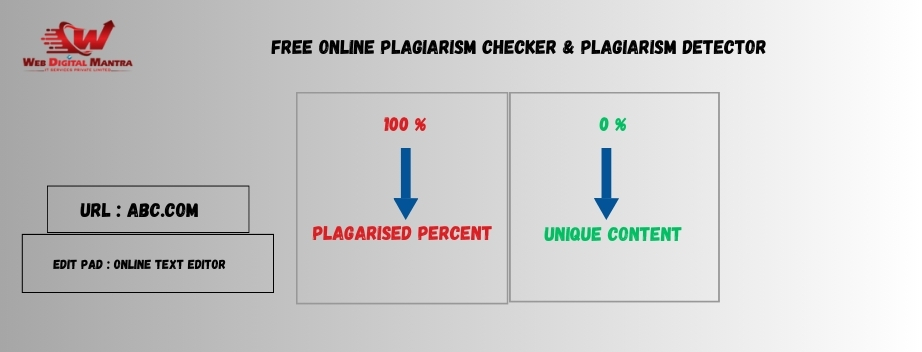
Plagiarism Checker - content is produced and shared at an unprecedented pace. Whether you're a student, teacher, writer, or professional, ensuring that your work is original is critical. Plagiarism—intentional or unintentional copying of someone else's work—can have serious consequences. Fortunately, free online plagiarism checkers and plagiarism detectors offer an easy solution to this problem. These tools help users verify the authenticity of their content and detect any unintentional overlap with existing sources.
Before diving into how online plagiarism checkers work, let's clarify what plagiarism entails. Plagiarism is the act of using someone else's ideas, words, or work without proper acknowledgment. In academic, creative, and professional settings, plagiarism can result in penalties ranging from loss of credibility to legal consequences.
Plagiarism can be:
Direct Plagiarism: Copying another’s work word-for-word without attribution.
Paraphrase Plagiarism: Rewriting someone’s ideas without giving credit.
Self-Plagiarism: Reusing your previous work without citing it as a source.
Accidental Plagiarism: Unintentionally failing to properly quote or cite sources.
Given the broad definition of plagiarism, even seasoned writers or students can unintentionally commit it. This is where free online plagiarism checkers come into play.
Whether you're working on an academic assignment, business report, blog, or book, using a plagiarism checker can save you from potential pitfalls. Here’s why these tools are essential:
1. Ensures Originality
A plagiarism checker ensures that your work is original and free from accidental plagiarism. The plagiarism checker free tools compare your content with a vast database of previously published materials, online sources, and academic papers.
2. Helps with Proper Citation
Plagiarism checkers can also identify improperly cited sources, helping you ensure that all borrowed ideas are properly attributed.
3. Avoids Serious Consequences
In academic or professional settings, plagiarism can lead to penalties, ranging from losing credibility to legal action. Using a plagiarism checker beforehand helps mitigate the risk.
4. Supports Ethical Content Creation
If you're a content creator or blogger, using a free plagiarism checker for students ensures that you're creating ethical, original work that doesn’t infringe on others' intellectual property rights.
Both free and paid plagiarism checkers are available, each offering various levels of depth and accuracy. Let’s break down their key differences:
Free Plagiarism Checkers
Free plagiarism checkers are popular for users who need quick and basic checks. These tools are ideal for students, writers, and educators with limited needs. Some well-known online plagiarism checkers include:
SmallSEOTools: A straightforward, user-friendly tool for quick plagiarism checks.
Grammarly (Free Version): Besides grammar checks, Grammarly’s free version also includes a basic plagiarism detection tool.
Plagscan: Offers a free trial, which provides a snapshot of the tool’s full features.
Paid Plagiarism Checkers
Paid tools offer more thorough searches, checking your work against both public and private databases. They also provide more detailed reports and are ideal for professional and academic users. Some of the best-paid tools include:
Turnitin Plagiarism Checker: Used by universities worldwide, Turnitin is considered one of the most reliable plagiarism detection tools.
Copyscape Premium: Popular among bloggers and content creators, Copyscape ensures that published online content is unique.
Grammarly Premium: The paid version of Grammarly provides a more robust plagiarism detection tool, scanning a wider range of sources.
Free Plagiarism Checker for Students
For students, using a free plagiarism checker for students is incredibly valuable, especially when writing essays, research papers, or assignments. Free tools provide basic checks, allowing students to ensure their work is free from accidental plagiarism. Popular options include tools like PlagiarismChecker.com and Duplichecker.
When selecting a plagiarism checker, consider these key features:
1. Large Database:
The more extensive the database, the better the tool will be at detecting plagiarism. The best plagiarism checkers cross-reference your content with academic papers, web pages, and previously published work.
2. Detailed Reports:
A good plagiarism checker will provide detailed reports highlighting sections of your content that overlap with other sources. Some even suggest proper citations.
3. User-Friendly Interface:
Ease of use is critical. Many users prefer online plagiarism checkers that offer a simple process—just paste your text, hit a button, and receive results in minutes.
4. Real-Time Checking:
Some tools, like Grammarly Premium, offer real-time plagiarism detection while you write, ensuring your content stays unique as you draft it.
5. AI-Powered Detection:
Some advanced plagiarism checkers now incorporate AI technology to identify not only direct plagiarism but also paraphrased content. AI plagiarism checkerscan detect more subtle forms of plagiarism, improving accuracy.
6. Cross-Language Checking:
Some tools can even check for plagiarism across different languages, making them useful for multilingual content creators.
Using an online plagiarism checker is straightforward. Follow these simple steps:
Step 1: Choose Your Tool
Decide whether you need a free or paid tool. For basic plagiarism checks, free options like Grammarly, SmallSEOTools, or Plagscan are great. For more in-depth analysis, consider Turnitin or Copyscape.
Step 2: Upload or Paste Your Content
Most tools allow you to either paste your text directly or upload a document. Some tools also support multiple file formats, including PDFs, Word documents, and more.
Step 3: Analyze the Results
Once the tool processes your document, it will generate a report highlighting any content matches. Some tools offer a website to check for plagiarism by comparing your text against web-based content.
Step 4: Review and Make Changes
If any part of your text is flagged, review the original source. If necessary, rephrase the content or add proper citations to ensure originality.
With the rise of artificial intelligence (AI), AI plagiarism checkers are now more advanced than ever. AI-powered tools not only detect exact matches but also identify paraphrasing, subtle rewording, and attempts to evade detection. This is particularly useful as many people try to "hide" plagiarism by rewording or restructuring text.
For instance, Quetext and Grammarly Premium use AI to enhance detection capabilities, making them better at identifying both direct plagiarism and more nuanced forms.
Advantages of AI Plagiarism Detection
More Accurate Results: AI-driven tools are better at detecting plagiarism, even when it's subtle or paraphrased.
Faster Processing: AI speeds up the plagiarism checking process, allowing for real-time feedback.
Enhanced Detection Algorithms: AI tools continuously improve their algorithms, offering more accurate results over time.
Using a plagiarism checker is only one step in ensuring originality. Here are some best practices to follow:
1. Cite All Sources:
Always give credit where it’s due. If you’re using someone else’s ideas or research, be sure to properly cite the source.
2. Use Quotation Marks for Direct Quotes:
When you directly quote a source, use quotation marks and include the citation.
3. Paraphrase Thoughtfully:
Simply changing a few words doesn’t make the content original. When paraphrasing, fully rewrite the idea in your own words and cite the original source.
4. Keep Track of Your Sources:
Maintain a list of all the references you consult during your research, making it easier to cite them properly later.
5. Check Your Work Regularly:
Make a habit of running your documents through a plagiarism checker, especially if you're dealing with academic or professional content.
A plagiarism checker free or paid can be a valuable tool in maintaining the originality of your content. Whether you're a student, writer, or professional, plagiarism detection ensures your work remains authentic, ethical, and credible.
For students, free options like Grammarly and SmallSEOTools provide quick checks, while professional writers might prefer advanced AI tools or Turnitin plagiarism checkers for more comprehensive results. Always opt for a best plagiarism checker that suits your needs and offers robust protection against accidental plagiarism.
1. Can I check plagiarism for free?
Plagiarism Detector is free to use, and users do not need to register. However, there is a limit of 1,000 words per document.
2.Can ChatGPT detect plagiarism?
The ChatGPT Plagiarism Checker, developed by PlagiaShield, is the perfect Chrome Extension for this purpose: - Unlimited plagiarism checks right from the ChatGPT website.
3.How to avoid ChatGPT plagiarism?
Paraphrasing is one of the most essential skills for using ChatGPT and preventing plagiarism. This is a brief synopsis: Your own words: Rephrasing information in your own words while maintaining the original meaning is essential to effective paraphrasing.
 Ganesh B R
Ganesh B R

As a client, I’m really impressed with the online plagiarism checker from Web Digital Mantra IT Services.

The free plagiarism checker provided by this company is excellent for quick detecting and addressing duplicate content.

A free online plagiarism checker helps you spot copied content quickly, ensuring your work is original.
Copyright @2020. All Rights Reserved by WEB DIGITAL MANTRA IT SERVICES PVT LTD
Post Reviews